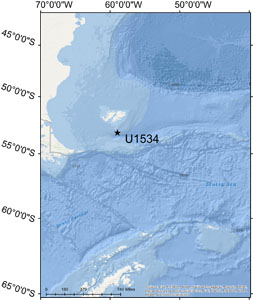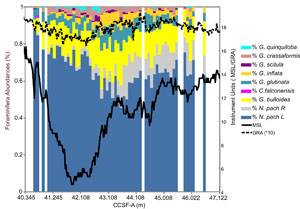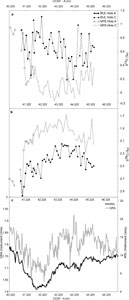Weber, M.E., Raymo, M.E., Peck, V.L., Williams, T., and the Expedition 382 Scientists
Proceedings of the International Ocean Discovery Program Volume 382
publications.iodp.org
https://doi.org/10.14379/iodp.proc.382.202.2025
Data report: MIS 11 planktonic foraminifera abundances and stable isotope records from IODP Holes U1534A and U1534C, Expedition 3821
A. Glueder,2 A.C. Mix,2 J. Padman,2 A. Ross,2 and V.L. Peck3
1 Glueder, A., Mix, A.C., Padman, J., Ross, A., and Peck, V.L., 2025. Data report: MIS 11 planktonic foraminifera abundances and stable isotope records from IODP Holes U1534A and U1534C, Expedition 382. In Weber, M.E., Raymo, M.E., Peck, V.L., Williams, T., and the Expedition 382 Scientists, Iceberg Alley and Subantarctic Ice and Ocean Dynamics. Proceedings of the International Ocean Discovery Program, 382: College Station, TX (International Ocean Discovery Program). https://doi.org/10.14379/iodp.proc.382.202.2025
2 College of Earth, Ocean and Atmospheric Sciences, Oregon State University, USA. Correspondence author: gluedera@oregonstate.edu
3 British Antarctic Survey, United Kingdom.
Abstract
International Ocean Discovery Program Site U1534 presents an opportunity to study the evolution of subantarctic surface waters in the Atlantic Ocean and investigate Subantarctic Front dynamics during glacial–interglacial transitions. Here we document stable carbon and oxygen isotopes (δ13C and δ18O) in the planktonic foraminifera Globigerina bulloides and Neogloboquadrina pachyderma (sinistral), as well as species abundances of all planktonic foraminifera present in the splice section of Site U1534 interpreted to represent Marine Isotope Stage 11 based on the shipboard stratigraphy. The planktonic assemblage is dominated by N. pachyderma (sinistral), with minor occurrences of other calcareous species; the lowest N. pachyderma (sinistral) abundances suggest the warmest upper ocean temperatures at ~43–44 m core composite depth below seafloor, Method A (CCSF-A). Results demonstrate that δ13C in N. pachyderma (sinistral) and G. bulloides varies from −0.12‰ to 1.01‰ and from 0.19‰ to 1.11‰, respectively. δ18O in N. pachyderma (sinistral) and G. bulloides varies from 1.68‰ to 2.92‰ and from 2.14‰ to 2.97‰, respectively. δ18O values oscillate through the section but are generally lowest near 43–44 m CCSF-A.
1. Introduction
Site U1534 is located at 53°11.38′S, 58°45.65′W (Figure F1), and was drilled during International Ocean Discovery Program (IODP) Expedition 382. The site is located on the northern flank of an east–west trending trough on the continental shelf ~660 km east of the Strait of Magellan, making Site U1534 a primary target to track migrations of the Subantarctic Front on millennial to orbital timescales. Sediments at this site are comprised of contourite drift deposits and are currently deposited beneath the Subantarctic Front at a 600 m water depth (Weber et al., 2019).
Here we document δ13C and δ18O in the planktonic foraminifera Globigerina bulloides and Neogloboquadrina pachyderma (sinistral), as well as species abundances of all planktonic foraminifera present in sections of Lithostratigraphic Unit I in Holes U1534A and U1534C. Based on shipboard stratigraphy, we interpret these data to represent Marine Isotope Stage (MIS) 11 (Weber et al., 2019).
2. Materials and methods
Lithostratigraphic Unit I contains interbedded foraminifera-bearing biosilica-rich silty clays composed of varying fractions of quartz, feldspar, and accessory opaque minerals. This interval, preliminarily identified as MIS 11, is the lowest of three carbonate-rich intervals and occurs in Sections 382-U1534A-5H-5 through 5H-CC and 382-U1534C-5H-2 through 5H-5. In Holes U1534A and U1534C, this section is a ~5 m thick light gray subunit composed of foraminifer- and nannofossil-rich biosiliceous ooze. Upper and lower transitions to over- and underlying biosiliceous silty clays are gradual and marked by partial bioturbation. Like the overall composition of the core, main components of the terrigenous fraction within this subunit are quartz, glauconite, and accessory opaque minerals.
For this study, we collected 54 samples (10 cm3) from split sections included in the composite depth record (CCSF-A), approximately every 10 cm, which translates to a temporal resolution of ~1000 y based on preliminary shipboard stratigraphy (Weber et al., 2019). Samples were processed at Oregon State University (OSU; USA), where all samples were shaken for 45 min in a dispersing and chelating solution (100 g (NaPO3)6 in 20 L distilled water) before being wet sieved at 125 µm and subsequently oven dried at 40°C. Dried samples were split to preserve half of the sediment as an archive sample. Where present, monospecific G. bulloides and N. pachyderma (sinistral) foraminifers in the dry residues were picked under a binocular microscope in the size range 125–250 µm, washed with ethanol in an ultrasonic bath (30 s), rinsed in distilled water, dried, and analyzed at the stable isotope lab at OSU (Kiel V/MAT253 Plus). Measurement precision was checked using an OSU internal standard (WILEY), and results were converted to the international Peedee belemnite (PDB) scale using NBS19 and local marble standard (± 1 σ analytical precision on standards δ18O = 0.04‰; δ13C = 0.02‰). Planktonic foraminiferal species counts were taken from the archive half of the sample and are expressed as percentages of each species relative to the total preserved planktonic foraminifera in the size fraction >125 µm.
3. Results
Sufficient sample material for stable isotope analyses was only present in samples below Sample 382-U1534A-5H-4, 114–116 cm (40.325 m CCSF-A), and above Sample 6H-1, 74–76 cm (45.602 m CCSF-A). Based on the preliminary ship-board age model (Weber et al., 2019), this corresponds to an age interval of approximately 375–431 ka.
3.1. Foraminifera species abundances
The relative species abundance data of the planktonic foraminifera are recorded in Table T1 and visualized in Figure F2. In general, foraminifera are absent above 40.625 m CCSF-A and below 45.408 m CCSF-A, with rare occurrences observed between 45.602 and 46.022 m CCSF-A. A single sample containing a rare specimen of N. pachyderma (sinistral), N. pachyderma (dextral), G. bulloides, Globigerinita glutinata, and Globigerina inflata was observed at 46.432–46.452 m CCSF-A. Preservation is mostly good with no obvious signs of dissolution. All assemblages are dominated by very small specimens (<125 µm). The lowest percentage of N. pachyderma (sinistral), implying the warmest upper ocean temperatures, is found at ~43–44 m CCSF-A and does not coincide with the lowest magnetic susceptibility data (MSL) and gamma ray attenuation (GRA) bulk density.
Foraminifera species present in this section are N. pachyderma (sinistral), N. pachyderma (dextral), G. bulloides, Globigerina falconensis, G. glutinata, G. inflata, Globigerina scitula, Globorotalia crassaformis, and Globigerina quinqueloba. In all samples, the dominant species are N. pachyderma (sinistral) and G. bulloides.
3.2. Stable isotopes
Stable isotope results are summarized in Table T1 and plotted in conjunction with shipboard MSL and GRA bulk density in Figure F3 on the CCSF-A depth scale. Results demonstrate that δ13C in NPS and G. bulloides varies from −0.12‰ to 1.01‰ and from 0.19‰ to 1.11‰, respectively. δ18O in N. pachyderma (sinistral) and G. bulloides varies from 1.68‰ to 2.92‰ and from 2.14‰ to 2.97‰, respectively.
Figure F3. δ18O and δ13C variations of Globigerina bulloides and Neogloboquadrina pachyderma (sinistral) and MSL and GRA bulk density.
Compared to published Holocene records of δ18O in N. pachyderma (sinistral) from Core GC528 (~45 km east-southeast of Site U1534; Roberts, 2016), the δ18O signal observed in the core sections analyzed here is as much as ~1‰ lower than the lowest recorded data in Core GC528, suggesting warmer and/or less saline conditions in MIS 11 than during the Holocene. This result contrasts with the findings of Hodell et al. (2000), who document that sea-surface temperatures at similar latitudes in the eastern South Atlantic during MIS 11 were likely not warmer than during other late Pleistocene interglacial stages.
4. Summary
Planktonic foraminifera were collected from the splice at Site U1534 between 40.325 and 46.452 m CCSF-A, which corresponds to MIS 11. The planktonic assemblage is dominated by N. pachyderma (sinistral), with minor occurrences of other calcareous species; the lowest N. pachyderma (sinistral) abundances suggest the warmest upper ocean temperatures at ~43–44 m CCSF-A. δ18O values oscillate through the section but are generally lowest near 43–44 m CCSF-A, in agreement with foraminifera species percentages during interglacial events such as MIS 11 near ~400–410 ka BP (Lisiecki and Raymo, 2005). Relatively warm conditions precede the lowest MSL and GRA bulk density values of the interval, which are near 41.5–42.5 m CCSF-A, indicating that lithologic variability within this interval does not reliably determine glacial–interglacial chronology. The δ18O is up to ~1‰ lower than observed in nearby Holocene sediments.
5. Acknowledgments
This research used samples and data provided by IODP under Sample Request 072917IODP. We are thankful for the support from the IODP Expedition 382 Science Party members, the crew of JOIDES Resolution, IODP staff, and the staff at the IODP Bremen Core Repository. This work was made possible by support from a United States Science Support Program postexpedition award to A. Glueder.
References
Hodell, D.A., Charles, C.D., and Ninnemann, U.S., 2000. Comparison of interglacial stages in the South Atlantic sector of the southern ocean for the past 450 kyr: implifications for Marine Isotope Stage (MIS) 11. Global and Planetary Change, 24(1):7–26. https://doi.org/10.1016/S0921-8181(99)00069-7
Lisiecki, L.E., and Raymo, M.E., 2005. A Pliocene-Pleistocene stack of 57 globally distributed benthic δ18O records. Paleoceanography, 20(1):PA1003. https://doi.org/10.1029/2004PA001071
Roberts, J., 2016. Insights into glacial terminations from a South Atlantic perspective [PhD dissertation]. University of Cambridge, Cambridge, UK. https://doi.org/10.17863/CAM.13432
Weber, M.E., Raymo, M., Peck, V.L., Williams, T., and the Expedition 382 Scientists, 2019. Expedition 382 Preliminary Report: Iceberg Alley and Subantarctic Ice and Ocean Dynamics. International Ocean Discovery Program. https://doi.org/10.14379/iodp.pr.382.2019


